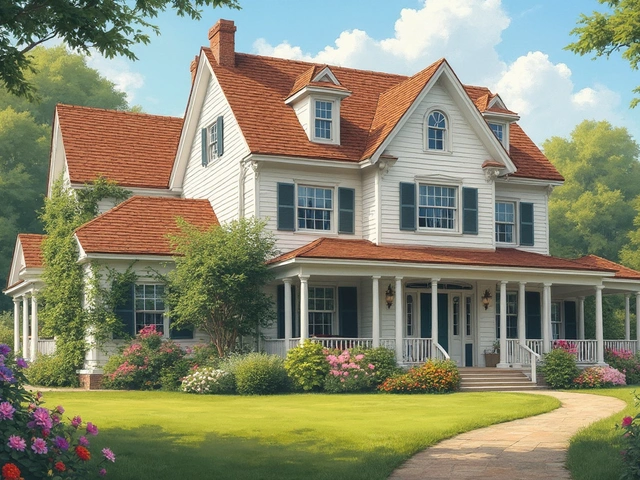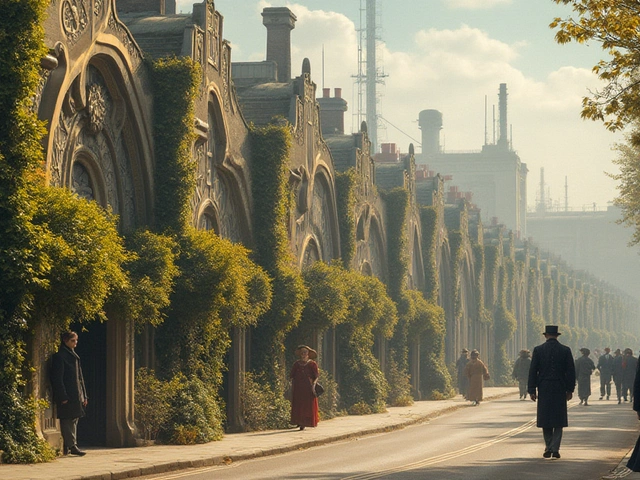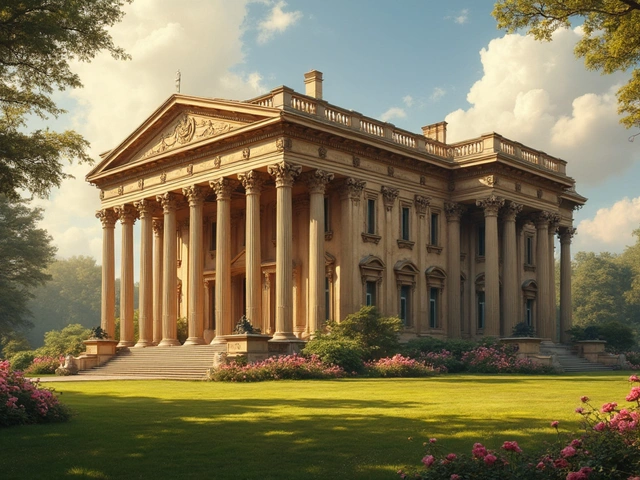Greek Revival architecture, a movement imbued with grandeur and an echo of ancient aesthetics, deeply influenced the building styles from the late 18th century to the mid-19th century. Its resurgence in popularity captured the imaginations of architects and patrons alike, as they sought to embody the democratic ideals and classical purity of ancient Greece in their own civic, institutional, and residential buildings.
This style, characterized by its symmetrical shape, imposing columns and elaborate friezes, not only connotes beauty but also a significant cultural narrative that mirrored the political climates of the times. From majestic courthouses to stately homes, Greek Revival architecture manifests a historical depth and an architectural enthusiasm that continues to enchant enthusiasts and professionals in the field.
- Historical Emergence
- Defining Characteristics
- Famous Examples
- Influence on Modern Architecture
- Preservation and Tourism
Historical Emergence
The seeds of Greek Revival architecture were sown during a time of burgeoning curiosity about antiquity, ignited by archaeological discoveries in Greece and the Mediterranean. This style first gained momentum in Europe, particularly in Germany and England, before sweeping through America in the early 19th century. As intellectuals and architects revisited the ancient texts and ruins, the democratic ideals of the ancient Greeks became synonymous with architectural expressions. This resurgence was not merely an adoption of Greek style but a reflection of societal aspirations towards democracy and enlightenment, mirroring the ancient Greek civilization's ideals.
By the late 1700s, the excavations at Herculaneum and Pompeii had captivated the Western world, drawing attention to Classical art and architecture. This newfound fascination was not just academic; it symbolized a broader cultural movement. Publications like Stuart and Revett's 'Antiquities of Athens' became seminal, influencing a wave of architectural designs based on precision drawings of Greek structures. The style's adoption was so widespread that it eventually came to symbolize civic pride and cultural identity in regions as diverse as Europe and the Americas. Its prominence peaked during the antebellum period in the United States, where it was deemed particularly appropriate for public and governmental buildings, embodying an air of permanence and authority.
Interestingly, the Greek Revival movement also coincided with significant political changes in Greece itself, including its war for independence in the 1820s. This not only heightened the style's romantic allure but also linked it directly with the spirit of freedom and self-determination. As American and European societies found themselves aligned with these ideals, the architecture further embedded itself as a marker of cultural and historical consciousness.
Defining Characteristics
Greek Revival architecture is often celebrated for its majestic simplicity and strong reference to classical antiquity. One of the most evident features of this architectural style is the use of thick columns, which draw inspiration directly from ancient Greek temples. These columns are typically of the Doric, Ionic, or Corinthian order, each with unique elements such as fluted shafts and decorative capitals that add a distinct aesthetic quality to the buildings.
Another defining characteristic is the front gable, typically edged with a triangular pediment that closely resembles the front face of an ancient temple. This element not only contributes to the symmetry of the structures but also enhances their grandeur and ties them to religious and cultural significance in Greek history. Furthermore, the facades are almost always constructed with horizontal transoms and often feature a series of evenly spaced large windows that help to illuminate the lofty interiors.
The use of white or light-colored paint is another key aspect that mirrors the luminous marble seen in original Greek architecture. This choice not only emphasizes the clean lines and geometric clarity of the style but also reflects sunlight dramatically, making the buildings gleam with an almost ethereal quality in the right light conditions. Internally, Greek Revival buildings often showcase high ceilings and expansive spaces, hinting at an aspiration towards grand living and open environments reminiscent of ancient public structures and communal spaces.
Detailing in Greek Revival architecture is not limited to the structural elements. Decorative motifs such as meanders, acanthus leaves, and Greek key patterns appear in moldings, friezes, and interior features, providing a rich texture and deepening the connection with classical themes. These patterns are more than mere decoration; they carry cultural resonance and contribute to the narrative that the architecture seeks to embody.
Critically acclaimed for bringing a slice of ancient classism into modern locales, Greek Revival architecture not only serves as a bridge to the past but also stands as a testament to the timeless appeal of Greek aesthetics. Its influence is evident in numerous public buildings and mansions, which were crafted to be as much a piece of art as functional structures. Such buildings often also feature large porticos that provide a dignified entrance, enhancing both the beauty and utility of these architectural pieces.
Famous Examples of Greek Revival Architecture
Throughout the world, certain structures serve as the quintessential representatives of Greek Revival architecture, each telling a unique story of its era and the ideals it sought to express. In the United States, the style found particular resonance, seen as reflective of the young nation’s democratic values and aspirations. One of the most iconic embodiments of this architectural style is the United States Capitol in Washington, D.C. Its design, with its large white columns and classic pediments, draws directly from the aesthetics of ancient Greek temples, symbolizing law, governance, and democracy.
Another notable example is The Brand Library & Art Center in Glendale, California. Originally constructed in 1904 as the residence of Leslie C. Brand, who was inspired by the 1893 World’s Columbian Exposition, it features a bold front entrance flanked by towering columns. The library embodies the grandiosity and the scholarly essence often associated with Greek Revival architecture. Its historical significance and aesthetic charm have combined to make it a beloved community landmark.
Moving beyond the United States, the influence of Greek Revival can also be traced in Europe where several buildings stand as testaments to this stylistic transference. The Helsinki Cathedral in Finland presents an exemplary case, completed in the mid-19th century. With its clean, bright exterior and its imposing columns, the cathedral mirrors the aesthetics of cathedrals found in ancient Greece, adapted to a Christian context and landscape. This building not only serves as a place of worship but also as a central part of Helsinki’s identity, pulling numerous visitors who come to admire its architectural splendor each year.
Each of these structures, while uniquely adapted to their practical functions and cultural contexts, shares common design elements typical of Greek Revival architecture: stringent symmetry, towering columns, and a clear homage to classical antiquity. These buildings illustrate how ancient Greek architectural principles were resurrected to craft a visual vocabulary that spoke of power, democracy, and education. Their enduring presence reaffirms the timeless appeal and versatility of the Greek Revival aesthetic in accommodating various functions and cultural expressions.
Influence on Modern Architecture
The legacy of Greek Revival architecture is profoundly embedded in the fabric of modern architectural design. While the style primarily flourished in the 19th century, its principles and aesthetics continue to inspire contemporary architecture, blending ancient motifs with new materials and technologies. Architects today often draw on the symmetry, columnar grandeur, and the emphatic front entrances characteristic of Greek Revival architecture to convey power, stability, and austerity in governmental and cultural buildings.
One of the most direct influences of Greek Revival on modern architecture can be seen in the persistent use of columns and pediments. These elements are no longer limited to public or institutional buildings but have also found their way into residential designs, lending an air of prestige and permanence that homeowners find desirable. Additionally, the emphasis on frontality and axial symmetry in Greek Revival has taught modern architects the importance of proportion and balance, influencing even the layouts of contemporary structures.
Renowned architecture critics often cite the way modern minimalist trends align with the clean lines and restrained decor seen in Greek Revival structures. This can be seen in the works of architects who focus on 'less is more', honing in on simplicity and function, but with a classical touch. Greek Revival's focus on horizontal lines and strong elements at the roof also find echoes in Modernist architecture, where they help to define the structure against its environment.
An interesting dialogue exists between the historical reverence of Greek Revival and the innovative ambitions of modern architecture. This interaction is evident in numerous high-profile projects where architects integrate classical Greek elements into futuristic designs. Such projects often aim to communicate a sense of timelessness, linking the past and the future.
Preservation and Tourism
The endeavor to preserve Greek Revival architecture intertwines not only with the safeguarding of structural integrity but also with sustaining cultural heritage. As heritage buildings, many Greek Revival structures serve both as active spaces and historical testaments, requiring delicate maintenance that respects their original materials and designs. Authorities and local communities often collaborate to ensure these iconic buildings withstand the test of time, which includes everything from routine repairs to comprehensive restorations that can span several years.
In the sphere of tourism, Greek Revival architecture has proven to be a significant draw. Cities rich in this architectural style, like New Orleans and New York in the United States, attract numerous visitors each year who come to marvel at the grand old mansions and public buildings. These sites are not only aesthetically pleasing but also serve as educational platforms through which the public can engage directly with history. Walking tours, guided by knowledgeable locals, often highlight the impressive architectural features, while simultaneously telling the stories of the individuals and historical events associated with these buildings.
Preservation efforts often receive a boost from such tourism, which generates revenue that can be reinvested into maintaining and restoring these historical structures. For example, the preservation of the iconic Greek Revival buildings in Athens, Georgia, is supported by both public funding and the proceeds from cultural tourism. Visitors contribute to the local economy, which in turn facilitates ongoing preservation work, creating a sustainable cycle that benefits both the community and the preservation of its historical assets. Heritage tourism not only helps in maintaining the physical structures but also revitalizes local economies and reinforces community pride in their historical landmarks.





